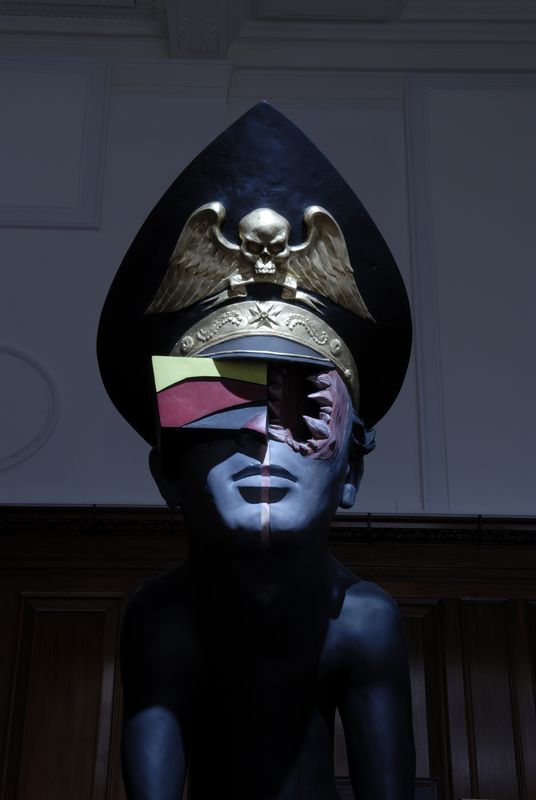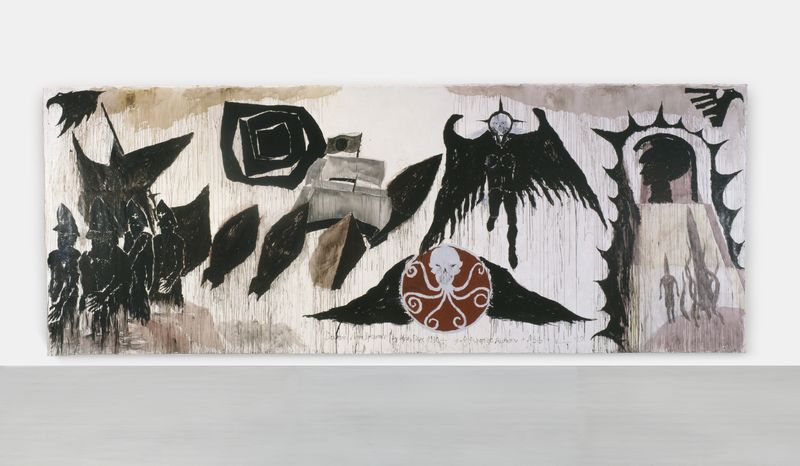
Andy Hope 1930
This Island Earth
31 March - 6 May 2006
London
The pictorial worlds of Andy Hope 1930 are poetic, familiar and irritating at the same time: science fiction pairs off with art history, comic book heroes appear side by side with emblems of the Third Reich, dark shapes and light figures share the same canvas. The German artist draws sensitive and subtle scenes that are nevertheless sombre. Upon closer inspection, his colourful and dreamlike imagery threatens to tip over into its opposite – a nightmare. His subject matter is built up into a complex and diverse system of signs that includes traditional images, removed from the popular lexicon, then consciously distorted and expanded.
The name Andy Hope 1930 stands for an interim person between the artist and his work. The name “Hope” radiates optimism, which is in direct contrast to the dark moods of his scenes or the historical landscape suggested by the date. With it, as Susanne Gaensheimer has remarked, the artist ‘marks them as timeless or also implies the timelessness of his own existence.’ (from the catalogue Welt ohne Ende (World without End), p. 11-12)
Hope refers to the 1930s, a decade that was marked by the development of film as the most powerful new tool of mass communication and also witnessed Germany’s transition from the Weimar Republic to National Socialism, from democracy to totalitarianism. The development of the historical avant-garde had to face a series of political and artistic crisis in European modernity, which was suppressed and replaced by the visual language of fascism. The artist uses the works of one of its lesser known protagonists, Werner Peiner, a successful artist during the Third Reich, deconstructing the irrational mysticism of his paintings and increasing the unconscious elements of his fantasies. He confronts its symbols with signs of modernism, comic strip or film in order to expose their superficial appeal.
Hope deliberately works in a variety of media, including painting, drawing, and collage, and connects these as an installation in a single atmospheric unit. He continually surprises with new combinations of media and experiments tirelessly with materials and different techniques of applying paint. In so doing, he develops a unique aesthetic that burns directly into the memory of the observer and operates in a way that is simultaneously crude and refined.
For “This Island Earth”, Hope has made a 36-foot long painting, which forms the focal point of the exhibition. It will be shown alongside tall sculptures, which seem to have sprung directly out of a science fiction film, their impressive size reminiscent, too, of representations of the Egyptian pharaohs. In spite of the sheer classical beauty of the installation, it nevertheless arouses a feeling of suspicion.
Andy Hope 1930’s subject matter brings various, sometimes controversial, themes together and creates connections that are filled with suspense. Unconstrained by possible misunderstandings, he mingles good and evil, mixes science fiction and history and presents sometimes provocative parallels. It is up to the observer to derive stories from the works – as well as to bear the tension created by them.
Selected images

Futur
2005

Outland
2006

War wyvers
2006

Phoenix
2006

Reich
2006

Kardinal Julian
2006

Futur
2005

Starling Sight
2002

Hololight
2005

Amazing
2005

Billy the Kid
2006

Spinner
1996

Random World
2005
Installation views


Related Content
Current Exhibitions

Piero Manzoni
‘L’invincibile Jean’ and Early Works 1956 – 1957
27 November 2025 – 14 February 2026
Basel

Piero Manzoni
‘L’invincibile Jean’ and Early Works 1956 – 1957
27 November 2025 – 14 February 2026
Basel
1 / 9



















